This article is Part 4 of a 5 Part series shedding some light into our Web Design Process. This article explains how we go about breathing a breath of life into your web design concepts and turn art into an application.
So we’ve laid the ground work with Research & Planning, crunched the data and produced your Architecture & Wireframe, made it pretty during Design, and now we need to turn that design into a website. This process is all about the nerds. But hey, someone once said that the nerds will rule the world. I don’t know about the world, but we sure do understand the Internet!
Here’s where resident nerd (aka Genius) Brian Onorio turns a Photoshop file into a fully functional and turn key website masterpiece!
Content Management
Virtually all of our websites are put onto a content management system which is an application allowing you to control the information on the website without having to be technically proficient. Our content management system of choice is WordPress, but we’ve worked with Joomla, Drupal, ExpressionEngine, and other notable products. Unless you have a specific choice for content management, we’ll go with the default WordPress (and you won’t be disappointed). We’ve done some pretty cool stuff with WordPress and we’re well experienced to craft WordPress into the CMS that you and your business need.
Functional
With an O3 website, you can rest assured that your new investment will marry functional ability with art. We browser test to assure that all current versions of Safari, FireFox, and Chrome will render your website as they appear on your earlier design concepts. We also assure that versions of Internet Explorer 7 and up are capable of rendering our websites.
We use jQuery to do the bulk of our client-side interactivity. Translated: we don’t use Adobe Flash to perform animations (like slideshow transitions) which is cross-platform compatible with all current browser versions as well as most mobile devices.
Search Engine Aware
We code to standard so that your website has the best chance of being picked and accessible by search engines. We will establish an Information Architecture that eases this process and lets search engines know what your content on each page is about. All of this is done behind the scenes and with little extra effort needed on your part.
We do provide search engine tools with each of our content managed sites allowing you to overwrite page titles and meta descriptions all within the content editing zones.
While search engine optimization requires much more than these controls, we do give you the best foot to stand on to allow your content to shine.
Alpha and Beta Testing
After the website build is complete, we rigorously test your website across various platforms to ensure that your website functions across popular platforms. We undergo alpha testing as a team which is where we catch a majority of the bugs. After Alpha, we will release to you and your team for Beta testing. With an additional set of eyes and a few more bugs to squash, we move forward with a release schedule.
With a workable, functional product, we’re ready for the final phase of our development cycle: Part 5 – Launch.

